|
|
 |
 |
 |
|
Waiting
for the minister's blessing. The ritual food is exhibited on the
board for the funerary banquet. Dobritsa, Rumania.
|
|
Hierarchs of
the prevailing regime in Rumania (...) married their children according
to modern uses and in conformity with the ideology of the regime, but burried
their dead according to religious rites and traditional ceremonies. Even
Ceaucescu, who was diabolized by the media, did not remain without funerals,
as it was discovered later (ibid, pp. 422-424). The active involvment of
the whole kin in the funerals of a close relative, the role distribution
according to age, sex, and degree of kinship with the deceased less retained
the attention of Rumanian scholars than the extraordinary show of the ceremonial
in the smallest villages and than the quality of the ritual performances
rendered to the dead at the various stages marking his separation from the
living, his admission to the other world (...). However, numerous aspects
of the rites practiced here are not elucidated,. More obscure are still
the relations that these rites entertain with uses of family life, standards
of religious cermonies and ostentatious civic celebrations. One is far from
understanding the relations that appear through these rites between articulation
by the language of texts said, uttered, shouted out or sung, on the one
hand, and voice utterance, attitudes and body postures on the other hand.
One is probably still farther from understanding the functioning of these
relations between the formulas explicited in texts, the beliefs expressed
by these formulas, and the irepresentations involved in the ones and the
others, and, lastly, the attitudes shown by the corresponding body language.

|



